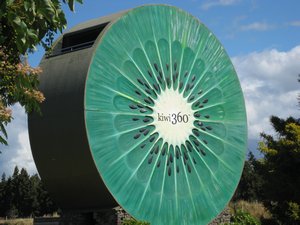Advertisement
Published: March 11th 2010

 NZ1 155
NZ1 155
Kiwi 360Imagine our excitment when we realized that we were mere kilometers from a Giant Kiwifruit.
It is located in Te Puke (the largest kiwifruit-growing area in New Zealand) and we came across it today during our drive from the Coromandel Peninsula to Rotorua.
We are both huge fans of Kiwis - the people, the birds and also the fruit. But here is a very important thing to know before traveling to New Zealand: as a tourist, you're more than welcome to call a New Zealander a "Kiwi". You can also call the bird of the same name a "kiwi" but the small fuzzy brown/green delicacy should always be called a "kiwifruit" (never just a "kiwi").
You've been warned!
The actual name of the place where the giant kiwifruit resides is "Kiwi 360" and it is easily spotted from the highway (see photos).
Inside Kiwi 360 is a thoroughly delightful educational and shopping experience. You can take the brilliant tram ride through the orchards in little kiwifruit-shaped cars ("KiwiCarts"), taste a surprising variety of liquers made from kiwifruit (who knew?), and shop for kiwifruit soap, candy, cookies, eyecream, etc.
Alas, we weren't able to do the

 NZ1 158
NZ1 158
Adrian with some kiwifruittram tour because they were waiting for a French tour group to show up - and they were already 2 hours late.
But we were able to ask some questions. So here is why we should dump apples and change the saying to "A kiwifruit a day . . .".
The kiwifruit has:
- More Vitamin C than two oranges
- The same amount of potassium as a banana
- Twice as much Vitamin E as an avocado
- The same amount of fibre as a bowl of bran flakes
- Only about 60 calories each
They're also reportedly rich in lutein, an antioxidant. What fascinates us the most about the kiwifruit is its potential blood-thinning properties. Similar to aspirin, as reported by a study from the University of Oslo, Norway, eating 2-3 kiwifruit per day for 28 days "significantly thins the blood, reducing the risk of clots, and lowers fat in the blood that can cause blockages" (taken from Wikipedia).
We're impressed with how healthy these little fuzzy fruit are.
Kiwifruit grow on vines, similar to grapes, and are also known as "Chinese gooseberries". In China today kiwifruit are more commonly known as "monkey

 NZ1 159
NZ1 159
Kiwifruit on the vine.peaches". Kiwifruit have a long and interesting history in New Zealand - they were first planted at the beginning of the 20th century. Kiwifruit were also the subject of a highly successful world-wide marketing campaign in the 1980s. New Zealand is the second largest producer of kiwifruit in the world these days (after Italy); the furry little guys are a major export, bringing in over $1 billion each year. Not bad for 60 calories.
Sadly, kiwifruit aren't in season in New Zealand at the moment. The supermarkets stock kiwifruit from Italy but they are not as tasty (the skin is a bit tougher and they don't seem very fresh). We hear that the kiwifruit harvest begins in March (autumn down here) and can't wait to try them then.
Advertisement
Tot: 0.158s; Tpl: 0.011s; cc: 12; qc: 55; dbt: 0.0754s; 1; m:domysql w:travelblog (10.17.0.13); sld: 1;
; mem: 1.1mb

 NZ1 155
NZ1 155
 NZ1 158
NZ1 158
 NZ1 159
NZ1 159
hikitia
non-member comment
kiwi fruit te ouke
kiwi fruit in te puke are great